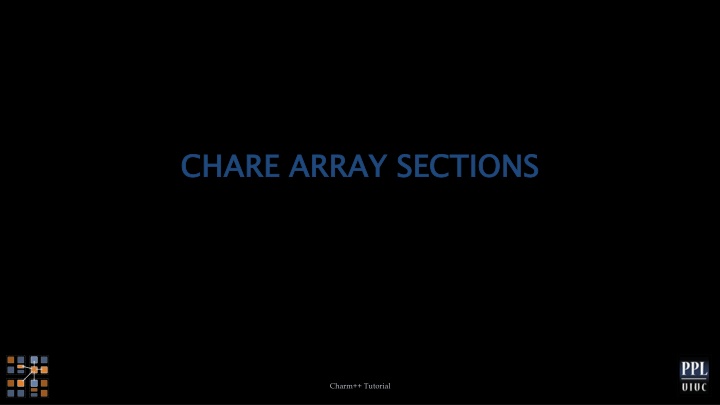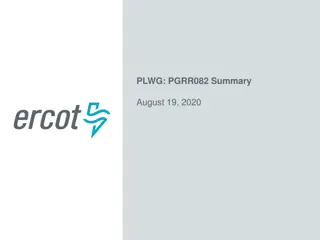
Chare Array Sections in Charm++ Tutorial
Learn about Chare Array Sections in Charm++ – how to create them, the motivation behind their use, section creation methods, section class generation, and examples of using sections for collective operations. Explore the concept of spanning trees in CkMulticast for efficient tree-based algorithms.
Download Presentation

Please find below an Image/Link to download the presentation.
The content on the website is provided AS IS for your information and personal use only. It may not be sold, licensed, or shared on other websites without obtaining consent from the author. If you encounter any issues during the download, it is possible that the publisher has removed the file from their server.
You are allowed to download the files provided on this website for personal or commercial use, subject to the condition that they are used lawfully. All files are the property of their respective owners.
The content on the website is provided AS IS for your information and personal use only. It may not be sold, licensed, or shared on other websites without obtaining consent from the author.
E N D
Presentation Transcript
CHARE ARRAY SECTIONS CHARE ARRAY SECTIONS Charm++ Tutorial
Chare Array Review Arbitrarily-sized collection of chares Every item in the collection has a unique index and proxy Can be indexed like an array or by an arbitrary object Can be sparse or dense Elements may be dynamically inserted and deleted Elements can be migrated cs598LVK 2 3/20/2025
Motivation It is often convenient to define subcollections of elements within a chare array Example: rows or columns of a 2D chare array One may wish to perform collective operations on the subcollection (e.g. broadcast, reduction) Sections are the standard subcollection construct in Charm++ A section is a subset of a Chare Array cs598LVK 3 3/20/2025
Section Creation Through explicit enumeration: CkVec<CkArrayIndex3D> elems; for (int i=0; i<10; i++) for (int j=0; j<20; j+=2) for (int k=0; k<30; k+=2) elems.push_back(CkArrayIndex3D(i, j, k)); // add array indices CProxySection_Hello proxy = CProxySection_Hello::ckNew(helloArrayID, elems.getVec(), elems.size()); cs598LVK 4 3/20/2025
Section Creation Through index range specification: Specify array ID of the base chare array and the inidvidual chare array elements of the array participating in the section CProxySection_Hello proxy = CProxySection_Hello::ckNew(helloArrayID, 0, 9, 1, 0, 19, 2, 0, 29, 2); cs598LVK 5 3/20/2025
Section Class Generation Section proxy classes are automatically generated for each chare and group defined in the .ci file Placed into decl.h and def.h files cs598LVK 6 3/20/2025
Using Sections CProxySection_Hello proxy; // section broadcast proxy.someEntry(...) //sections are unranked, not allowed proxy[0].someEntry(...) For example implementations, see $(CHARM)/examples/charm++/arraysection https://charmplusplus.org/miniApps/#leanmd cs598LVK 7 3/20/2025
Spanning Trees CkMulticast implements tree algorithms for multicasts and reductions Messages are routed over a spanning tree of the section elements Default branching factor is 2, but a different number can be specified while creating a section Add branching factor as a last integer parameter cs598LVK 8 3/20/2025
CkMulticast Messages To use CkMulticast library, all multicast messages must inherit from CkMcastBaseMsg CkMcastBaseMsg must be inherited from first No parameter marshalling is allowed in entry methods used as targets of multicast class HiMsg : public CkMcastBaseMsg, public CMessage_HiMsg { public: int *data; .. }; cs598LVK 9 3/20/2025
Reductions: setReductionClient An array element can be a member of multiple array sections It is necessary to disambiguate which array section reduction it is participating in each time it contributes to one The reduction callback should be set at the time of creation. This callback will be invoked after each reduction is complete CkCallback *cb = new CkCallback( CkReductionTarget (Cell, reduceForces), thisProxy(thisIndex.x,thisIndex.y,thisIndex.z))); mySecProxy.setReductionClient(cb); cs598LVK 10 3/20/2025
Reductions: CkSectionInfo A data structure called ''CkSectionInfo'' is created by CkMulticastMgr for each array section that the array element belongs to During a section reduction, the array element must pass the CkSectionInfo as a parameter in the contribute() This CkSectionInfo cookie can be retrieved from a previous message that was sent through CkMulticastMgr Therefore, you can contribute into a reduction only the same section. only following a broadcast to cs598LVK 11 3/20/2025
Reductions with CkMulticast CkSectionInfo cookie; void SayHi(HiMsg *msg) { // this is a broadcast to SayHi using // the section we want to to contribute to //update section cookie every time CkGetSectionInfo(cookie, msg); int data = thisIndex; mcastGrp->contribute(sizeof(int),&data, CkReduction::sum_int, cookie); } cs598LVK 12 3/20/2025
Callbacks As with array reductions, a callback needs to be specified with each contribute OR a default callback should be specified using setReductionClient cs598LVK 13 3/20/2025
Example: Matrix Multiplication Inputs: 2D chare arrays A, B of matrix blocks Output: 2D chare array C of matrix blocks Elements of A and B multicast their blocks to a section comprising a row or column of C Exercise: implement algorithm cs598LVK 14 3/20/2025
Example: LeanMD Lennart-Jones Dynamics We have a 3D array of Cells And a 6D array of cell-pairs (also called compute objects in the leanmd miniApp at https://charmplusplus.org/miniApps/#leanmd ) cs598LVK 15 3/20/2025
Object Based Parallelization for MD: Force Decomposition + Spatial Decomposition Now, we have many objects to load balance: Each diamond can be assigned to any proc. Number of diamonds (3D): 14 Number of Patches 2-away variation: Half-size cubes 5x5x5 interactions 3-away interactions: 7x7x7
Parallelization Using Charm++ The computation is decomposed into natural objects of the application, which are assigned to processors by Charm++ RTS
LJdynamics - Cell entry void run() { for(stepCount = 1; stepCount <= finalStepCount; stepCount++) { atomic { sendPositions(); } for(forceCount=0; forceCount < inbrs; forceCount++) when receiveForces[stepCount](int iter, vec3 atomic { addForces(forces); } atomic { updateProperties(); } if ((stepCount % MIGRATE_STEPCOUNT) == 0) { atomic { sendParticles(); } when statements for receiving particles from neighbors } }//end of for loop atomic { contribute(0, CkReduction::NULL, CkCallback(CkReductionTarget(Main,done),mainProxy)); } }//end of run forces[n], int n)
LJdynamics - Pair entry void run() { for(stepCount = 1; stepCount <= finalStepCount; stepCount++) { if (thisIndex.x1==thisIndex.x2 && thisIndex.y1==thisIndex.y2 && thisIndex.z1==thisIndex.z2) when calculateForces[stepCount](ParticleData *data) atomic { selfInteract(data); } else { when calculateForces[stepCount] (ParticleData *data) atomic { bufferedData = data; } when calculateForces[stepCount](ParticleData *data) atomic { interact(data); } } // contribute/send forces to the cells involved }//enf of for loop };//end of run
Using section in sendPositions Especially useful if you are using a 2-away formulation: There are 5x5x5 = 125 pairs to which each cell must send its coordinates Same data to everyone, so it is a Multicast This happens repeatedly, every iteration At load balancing time the locations of pairs may change, but the set is the same So, each cell sets up its own section of pairs Each pair is a member of two [or one] sections cs598LVK 20 3/20/2025
Expressing in Charm++ Two chare arrays: Cells: a 3D array of chares Pairs: one object for each neighboring chare What is the dimensionality of pairs ? Idea 1: make it a 3D array.. Does it work? Idea 2: Make it a 1D array, Explicitly assign indices to chares: the pair object between Cells[2,3,4] and Cells[2,3,5] is Pairs[someIndex]. Idea 3: Make it a 6D array Pairs[2,3,4,2,3,5] But: (a) it is sparse and (b) symmetry? Do we also have Pairs[2,3,5,2,3,4] Use only one of them.. (say smaller in dictionary order)
Object Based Parallelization for MD (with sections) All pairs in the box constitute a section for the central proc: Central chare uses CkMulticast for optimized broadcasts to this section Without CkMulticast, it would have been point-to-point sends for all Reductions are used across the section to aggregate results for force calculation






















